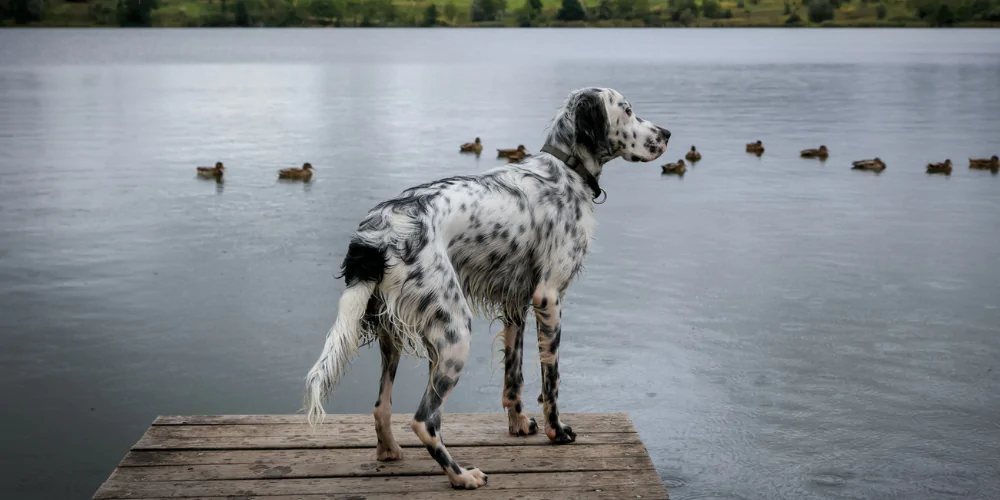
Why is my dog’s tail hanging limp after swimming?

Dr Rachel Cox, FirstVet vet
14 September 2021 | 4 minutes read
Have you ever noticed your dog’s tail hanging limp? If your dog’s tail is hanging down, they may be suffering from a condition called limber tail syndrome. Other names for this fairly common occurrence include frozen tail, cold tail, and acute caudal myopathy. Join FirstVet vet Dr Rachel Cox as she takes a look at the condition and its causes.
Table of Contents
- Limber tail syndrome
> Dog breeds prone to limber tail syndrome - Causes of limp tail in dogs
- Limp tail symptoms
- How is limber tail treated?

Limber tail syndrome
Frozen tail syndrome in dogs affects the muscles at the base of your dog’s tail, which causes their tail to dangle limply between their legs. The condition appears to be painful for dogs, so it’s important to know how limp tail can develop, as well as what steps you can take to protect your pup.
Some dogs may be more prone to limber tail syndrome than others. Male dogs, for instance, have an increased risk of developing cold tail, as do certain breeds.
> Dog breeds prone to limber tail
Working and hunting breeds are particularly vulnerable to limber tail syndrome due to their highly active lifestyles. We’re talking canines such as:
- English pointers
- English setters
- Foxhounds
- Beagles
- Labrador retrievers
But don’t take this as a hard and fast rule, as frozen tail can affect many other dog breeds.

Causes of limp tail in dogs
Prolonged and frequent swimming/splashing is just one of the activities that can lead to limp tail.
The exact physical cause of cold tail in dogs is unknown, but it’s thought to be caused by a restriction of the blood supply to the tail muscles. As dogs frequently use their tails to help steer and balance, especially during activities such as swimming, you can see how much of a problem limber tail can be.
A combination of cold and watery conditions can cause dogs to suffer from limber tail. This can be anything from playing in the sea at the beach to bathing in water that is too hot or too cold.. To protect your pooch while they’re having their aquatic fun, be mindful of the temperature of the water and the duration of their swim sessions.
Overexertion of the tail can also cause cold tail in dogs. Does your dog have an overly waggy tail when they’re playing or out hunting? Their tendency to turn their tails into windmills could lead them to develop limber tail. Whether caused by excessive swimming, playing or hunting, limber tail can last for around 1-2 weeks.
A limp tail can be a symptom of problems other than frozen tail syndrome, such as lower back and tail damage, a neurological problem, or even nutritional issues. Not sure what’s wrong with your dog? FirstVet has a 24/7 online service where you can get advice by booking a video appointment with a fully qualified vet. When you take out a dog policy with Petsure, you’ll have unlimited access to FirstVet’s online vet advice service.
If your pup has a poorly tail, FirstVet can help you to find a physical vet clinic in your area. They can perform a thorough neurological examination or take x-rays to confirm if it is limber tail syndrome or another illness.

Limp tail symptoms
The most common sign of the condition is your dog’s tail hanging limply. As limber tail can be quite painful for your dog, it’s important to also look out for these other signs:
- Pain or discomfort when walking
- Whimpering or crying
- Difficulty walking or standing
- Unable to get comfortable in their bed
- Discomfort or difficulty when toileting
If your pet is seriously injured or in need of immediate medical assistance, contact your local vet.

How is limber tail treated?
As we mentioned, it’s really important to seek expert advice from your vet if you believe your dog may have symptoms of limber tail. The condition is usually nothing serious and the likelihood of recovery is excellent. Complete recovery can normally be expected anywhere within a few days to two weeks. Reach out to FirstVet via their 24/7 online appointment service for support and treatment recommendations.
If you are then referred for an in-person appointment by FirstVet, here’s what you can do in the meantime to help ease your dog’s pain and prevent further injury:
- Help your dog get as comfortable as possible.
- Limit walks/activity to avoid overexercise and encourage your pet to rest.
- Use warm packs or compresses as these can help relax your pet’s muscles.
- Prevent your dog from being fully immersed in waters with extreme temperatures, or for prolonged periods of time.
- Keep your dog warm and dry, preferably with a warm blanket if the weather is cold.
Once you’ve been to visit the vet, use any medication prescribed to reduce pain and speed up healing.
If you’re ever unsure about what could be wrong with your dog, don’t forget that FirstVet is always on hand to provide online support and guidance. You’ll then need to bring your dog into a vet clinic for a full diagnosis and treatment plan.
We get that keeping your canine’s tail wagging is super important. It’s why we’re fighting for fair dog insurance for all pups, even those with pre-existing conditions.


